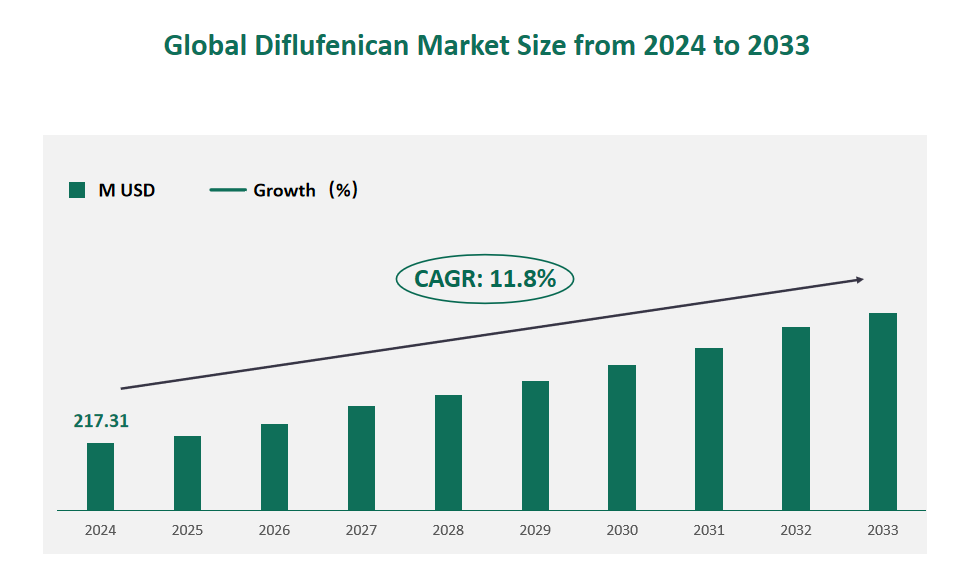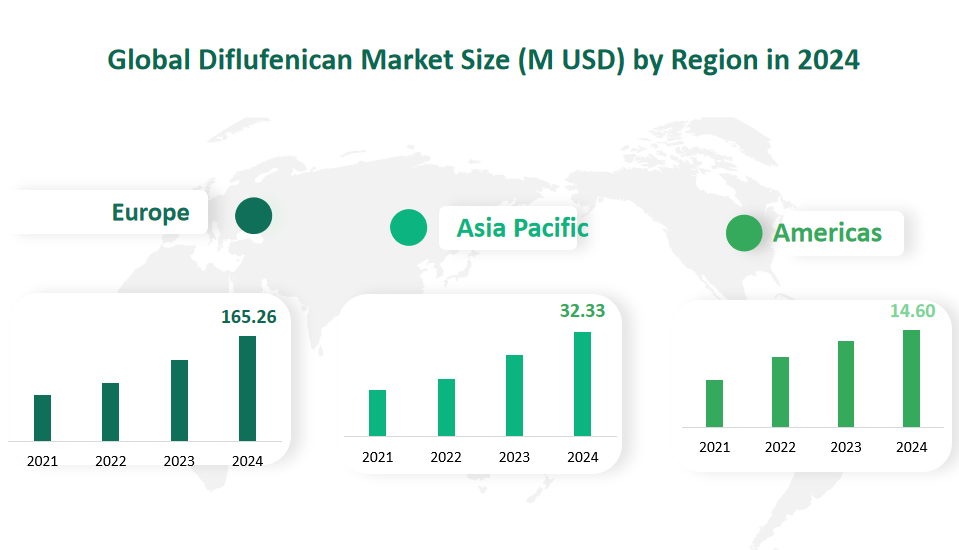1 Global Diflufenican Market Size (Value) and CAGR (2024-2033)
In 2024, the global Diflufenican market was valued at USD 217.31 million, with a CAGR of 11.8% from 2024 to 2033.
Diflufenican is a pyridinecarboxamide that is pyridine-3-carboxamide substituted by a 2,4-difluorophenyl group at the carbamoyl nitrogen and a 3-(trifluoromethyl) phenoxy group at position 2. It has a role as an environmental contaminant, a xenobiotic, an herbicide and a carotenoid biosynthesis inhibitor. It is an aromatic ether, a member of (trifluoromethyl)benzenes and a pyridinecarboxamide.
Figure Global Diflufenican Market Size (M USD) and CAGR 2024-2033

2 Diflufenican Market Drivers
The global Diflufenican market is driven by several key factors that contribute to its growth and expansion. One of the primary drivers is the increasing demand from key regions, particularly in the Asia-Pacific area. Countries such as China and India are experiencing rapid population growth and rising disposable incomes, which in turn increases the demand for food. This surge in food demand necessitates higher agricultural productivity, making herbicides like Diflufenican essential for controlling weeds and maximizing crop yields. For instance, in China, the complex weed situation in wheat fields has led to a significant demand for high-quality herbicides, driving the market for Diflufenican.
Diflufenican is a selective herbicide used to control broad-leaved weeds in crops such as cereals and fruits. With the global population projected to reach 10 billion by 2050, the demand for food is expected to increase dramatically. This will require more arable land and higher crop production, leading to an increased need for herbicides like Diflufenican.
3 Diflufenican Market Restraints
Despite its growth potential, the Diflufenican market faces several challenges that could hinder its expansion. One of the primary challenges is groundwater contamination. Synthetic herbicides like Diflufenican can leach into groundwater, posing risks to aquatic life and human health. This has led to stricter regulations and increased scrutiny from environmental agencies. For example, in Sweden, levels of Diflufenican in freshwater have exceeded national and European thresholds, highlighting the need for more sustainable alternatives.
These natural alternatives are gaining traction due to their environmental benefits and lower toxicity levels. Bioherbicides are made from microorganisms that target specific weeds without harming non-target areas or crops. They are also cost-effective and reduce farming expenses, making them an attractive option for farmers. This shift towards bioherbicides could potentially limit the market share of synthetic herbicides like Diflufenican.
The diminishing availability of arable land is a growing concern. According to the Food and Agriculture Organization (FAO), the global area under arable land has decreased significantly, while the demand for food continues to rise. This mismatch between supply and demand puts pressure on farmers to maximize yields, but it also limits the potential market for herbicides like Diflufenican.
4 Global Diflufenican Market Consumption (Tons) by Type in 2024
Powder Diflufenican is expected to account for 1,530 tons of the total consumption in 2024. This type of Diflufenican is typically used as a raw material in the production of herbicides. It appears as a white to light yellow or light orange powder or crystal. Powder Diflufenican is often used in the manufacturing process to create the final liquid herbicide product. Its versatility and ease of handling make it a preferred choice for many manufacturers. The powder form is stable and can be easily transported and stored, which adds to its appeal. Additionally, it can be mixed with other ingredients to create specific formulations tailored to different agricultural needs.
Liquid Diflufenican is the final product used directly in agricultural applications. In 2024, the consumption of Liquid Diflufenican is forecasted to be 3,098 tons. This type is a pre- and early post-emergence herbicide designed to control dicotyledonous weeds in winter cereals, including species such as Galium aparine and Veronica hederifolia. The liquid form is applied directly to the fields and is effective in controlling weeds that can reduce crop yields. Liquid Diflufenican is formulated to be used in sprayers, ensuring that the herbicide is evenly distributed over the target area. Its immediate effectiveness and ease of application make it a valuable tool for farmers.
Table Global Diflufenican Market Consumption (Tons) by Type in 2024
Type | Market Consumption (Tons) 2024 | Market Share 2024 |
Powder | 1530 | 33.06% |
Liquid | 3098 | 66.94% |
5 Global Diflufenican Market Consumption (Tons) by Application in 2024
In 2024, the consumption of Diflufenican in the Fruit category is forecasted to be 310 tons. Diflufenican is used in fruit cultivation to control weeds that can compete with fruit trees and bushes for nutrients and water. Its application helps maintain high yields and fruit quality by reducing weed interference.
The Cereal application is expected to account for the largest portion of Diflufenican consumption, with 4,092 tons forecasted for 2024. Diflufenican is widely used in cereal crops like wheat, barley, and rye to control broad-leaved weeds. These crops are often susceptible to weed infestations, which can significantly reduce yields if left unchecked. Diflufenican’s effectiveness in controlling weeds such as chickweed and speedwell makes it a preferred choice for cereal farmers worldwide.
Table Global Diflufenican Market Consumption (Tons) by Application in 2024
Application | Market Consumption (Tons) 2024 | Market Share 2024 |
Fruit | 310 | 6.71% |
Cereal | 4092 | 88.41% |
Others | 226 | 4.88% |
6 Global Diflufenican Market Size by Region in 2024
Europe remains the largest market for Diflufenican, with a forecasted value of 165.26 million USD in 2024. This region has a long history of using Diflufenican in cereal crops, particularly in countries like Germany, France, and the UK. The well-established agricultural industry and the need for high-yield crops drive the demand for effective herbicides like Diflufenican.
The Asia-Pacific region is the second-largest market, with a forecasted value of 32.33 million USD in 2024. This region’s market is driven by rapid population growth and increasing demand for food, particularly in countries like China and India. The need for higher agricultural productivity has led to increased adoption of Diflufenican in cereal and fruit cultivation.
The Americas market is forecasted to be worth 14.60 million USD in 2024. The United States and Canada are significant consumers of Diflufenican, primarily for cereal crops. The region benefits from advanced agricultural technologies and practices, which support the effective use of herbicides.
Figure Global Diflufenican Market Size by Region in 2024

7 Major Players in Global Diflufenican Market
7.1 Bayer
Bayer is a global enterprise with core competencies in the life science fields of health care and nutrition. Established in 1863 and headquartered in Germany, Bayer is committed to driving sustainable development and generating a positive impact with its businesses. The company’s products and services are designed to support efforts to master the major challenges presented by a growing and aging global population. In the context of Diflufenican, Bayer is known for its innovative approach to crop protection.
The company plans to launch large florfenicon under the brand name Convintro™, targeting weeds such as waterhemp and Palmer Amaranth. Pending EPA approval, Convintro products will be available for soybean growers for burndown and pre-emergence applications.
In the most recent year, Bayer’s Diflufenican sales reached 1,387 tons, generating a revenue of 98.00 million USD.
7.2 Jiangsu Huifeng Agrochemical Co., Ltd.
Jiangsu Huifeng Agrochemical Co., Ltd. is a nationally renowned pesticide enterprise in China, integrating R&D, production, and domestic and international trade. Established in 1989, the company has become an industry-leading R&D and industrialization base for several key pesticides, including Prochloraz TC, Capryloyl Bromoxynil TC, and Epoxiconazole TC.
The company’s business overview highlights its commitment to providing high-quality agrochemicals to both domestic and international markets. In terms of Diflufenican, Jiangsu Huifeng Agrochemical Co., Ltd. offers a 97% pure form of the herbicide, which is effective in controlling broad-leaved weeds in crops.
In the most recent year, the company’s Diflufenican sales amounted to 591 tons, with a revenue of 25.16 million USD.
7.3 Oxon
Oxon is a leading agrochemical company founded in 1970 in Italy. The company specializes in the chemical synthesis of out-of-patent active agrochemicals and has built top-level know-how and integration capabilities with several industries, including agrochemicals and pharmaceuticals. Oxon’s business overview emphasizes its dedication to producing high-quality agrochemicals that meet the needs of modern agriculture.
In the Diflufenican market, Oxon offers a product that is effective in controlling broad-leaved weeds in winter cereals and spring barley. The company’s Diflufenican is a selective contact and residual herbicide, absorbed principally by the shoots of germinating seedlings.
In the most recent year, Oxon’s Diflufenican sales reached 364 tons, generating a revenue of 23.51 million USD.

